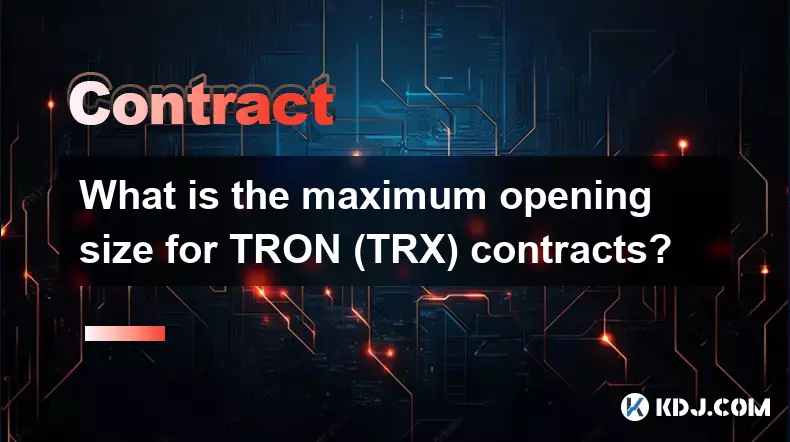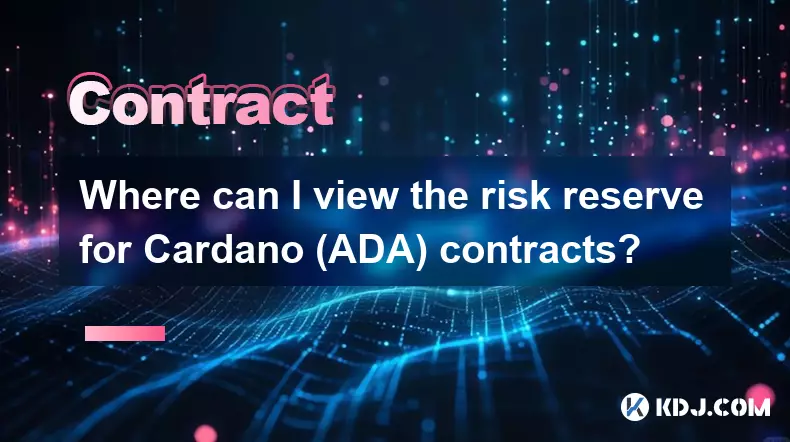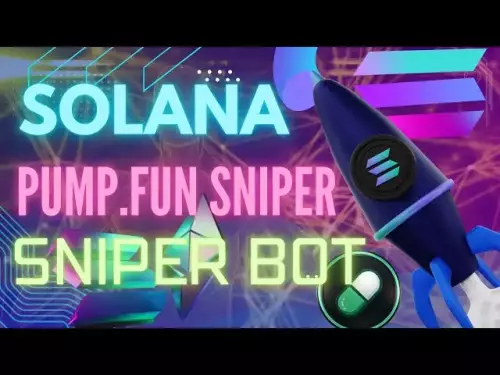-
 bitcoin
bitcoin $112195.049338 USD
2.42% -
 ethereum
ethereum $4124.915858 USD
2.81% -
 tether
tether $1.000570 USD
0.02% -
 xrp
xrp $2.861568 USD
2.25% -
 bnb
bnb $1000.346670 USD
3.04% -
 solana
solana $209.070819 USD
3.38% -
 usd-coin
usd-coin $0.999870 USD
0.02% -
 dogecoin
dogecoin $0.235379 USD
2.65% -
 tron
tron $0.335681 USD
-0.20% -
 cardano
cardano $0.803501 USD
3.38% -
 hyperliquid
hyperliquid $47.120881 USD
3.56% -
 chainlink
chainlink $21.501300 USD
3.44% -
 ethena-usde
ethena-usde $1.000571 USD
0.02% -
 avalanche
avalanche $29.793378 USD
3.62% -
 stellar
stellar $0.366964 USD
2.42%
What is the maximum opening size for TRON (TRX) contracts?
TRON smart contracts, written in Solidity and deployed on the TVM, face size limits due to block constraints (4MB) and energy costs, not a fixed "maximum opening size."
Sep 28, 2025 at 02:01 am

Understanding TRON (TRX) Smart Contract Capabilities
1. The TRON network supports smart contracts through its virtual machine, known as the TVM (TRON Virtual Machine). These contracts are written in Solidity and function similarly to those on Ethereum, allowing developers to create decentralized applications and issue tokens. Unlike some blockchain platforms, TRON does not impose a specific 'maximum opening size' for contracts in terms of initial deployment footprint. Instead, limitations are governed by block size constraints and energy costs.
2. Every contract deployment consumes bandwidth and energy resources on the TRON network. Users must either freeze TRX to obtain these resources or pay in Bandwidth Points. The actual size of a contract’s bytecode affects how much energy is required to deploy it. Extremely large contracts may exceed the available energy limit unless sufficient TRX has been frozen to cover execution costs.
3. Block size on TRON is capped at 4MB per block, which indirectly limits the maximum size of transactions and smart contract deployments that can be included in a single block. This means that while there isn’t a hardcoded cap on a contract's individual size, practical deployment is constrained by this upper threshold. A contract whose bytecode approaches or exceeds several hundred kilobytes could face rejection if it cannot fit within a block alongside other transactions.
4. Developers are encouraged to optimize their contract code to remain well under potential thresholds. Large contracts not only risk deployment failure but also increase the cost and complexity of interaction. Modular design patterns, such as using libraries or proxy contracts, are commonly adopted to manage complexity and reduce on-chain footprint.
5. The TRON network adjusts resource pricing dynamically based on network congestion. During peak usage periods, deploying large contracts becomes more expensive in terms of energy and bandwidth. This economic model ensures network stability but requires developers to carefully plan deployment strategies, especially for complex dApps requiring multiple contract interactions.
Contract Size and Network Efficiency
1. Efficient contract design directly impacts transaction speed and success rate on TRON. Contracts with bloated bytecode take longer to process and validate, increasing the likelihood of timeouts or reverts during deployment. Minimizing redundant functions and leveraging external calls instead of embedding logic internally helps maintain optimal performance.
2. The TVM executes every operation within a contract, and each opcode carries an associated energy cost. Larger contracts typically include more opcodes, driving up total energy consumption. If the total energy required surpasses the account’s available balance, the deployment fails even if the bytecode itself is technically within acceptable size limits.
3. TRON nodes validate incoming blocks and will reject oversized transactions that threaten network throughput. While no official documentation states a fixed number like “maximum opening size,” real-world testing shows that contracts exceeding 300–400KB often encounter issues unless deployed under low network load and with premium resource allocation.
4. Compression techniques are not applicable to contract bytecode since it must be executed verbatim by the TVM. However, tools like TronGrid’s compiler optimizer can reduce bytecode size by removing unused variables and simplifying expressions. Using recent versions of Solidity with enabled optimization settings is critical for large-scale deployments.
5. Monitoring tools such as Tronscan allow developers to inspect previously deployed contracts and analyze their size and resource usage. By studying successful large contracts, teams can estimate safe upper bounds for their own projects and avoid hitting implicit network ceilings.
Resource Management in TRON Deployments
1. To deploy any smart contract on TRON, users must have adequate bandwidth and energy. Bandwidth is used for transaction inclusion, while energy determines computational capacity. Freezing TRX grants both resources proportionally, making it essential for deploying non-trivial contracts.
2. Unfrozen accounts rely on free daily bandwidth and paid energy from the energy market. For large contracts, depending solely on free resources is impractical. Most professional deployments involve freezing hundreds or thousands of TRX to ensure smooth execution without delays or failures.
3. Energy price fluctuations occur based on demand. When many developers deploy contracts simultaneously, energy prices rise, affecting affordability for large deployments. Planning deployment during off-peak hours can significantly reduce costs and improve success rates.
4. Multi-phase deployment strategies are common for extensive dApp ecosystems. Instead of deploying one monolithic contract, developers split functionality across multiple smaller contracts deployed sequentially. This approach reduces per-transaction load and allows better error handling and upgrades.
5. The TRON Foundation provides developer incentives and grants for innovative projects. Some programs include resource subsidies, offering temporary relief from high energy costs during initial rollout phases. These support mechanisms help mitigate risks associated with large contract deployments.
Frequently Asked Questions
What determines the success of a large TRON smart contract deployment?Success depends on sufficient energy and bandwidth availability, optimized bytecode size, network congestion levels, and proper timing of the transaction submission. Ensuring adequate frozen TRX and using compiler optimizations greatly increases the chances of successful deployment.
Can I upgrade a smart contract after deployment on TRON?Native smart contracts on TRON are immutable by default. However, developers can implement upgradeable patterns using proxy contracts and delegatecall mechanisms. This requires careful architectural planning before initial deployment.
How do I check the size of my compiled TRON contract?After compiling your Solidity code using Remix or TronBox, examine the generated bytecode length. Development frameworks often display the size in bytes or kilobytes. You can also use online analyzers or verify the contract on Tronscan post-deployment to view detailed metrics.
Are there tools to optimize TRON smart contract size?Yes, Solidity compilers offer optimization flags that minimize bytecode output. Tools like Slither and MythX can identify redundant code. Additionally, using libraries for shared functions and enabling optimizer settings during compilation helps reduce overall contract footprint.
Disclaimer:info@kdj.com
The information provided is not trading advice. kdj.com does not assume any responsibility for any investments made based on the information provided in this article. Cryptocurrencies are highly volatile and it is highly recommended that you invest with caution after thorough research!
If you believe that the content used on this website infringes your copyright, please contact us immediately (info@kdj.com) and we will delete it promptly.
- Bitcoin Cloud Mining: Your Ticket to Crypto Passive Income in 2025?
- 2025-09-29 22:25:11
- MoonBull: Your Ticket to Explosive Crypto Launch ROI?
- 2025-09-29 22:25:11
- Crypto Presales: Is Lyno AI the Next Big Thing? Buy Now?
- 2025-09-29 22:30:01
- Unearthing Altcoin Gems: Crypto Opportunities with 1000X Potential in 2025
- 2025-09-29 22:30:01
- Ethereum Meme Coins: Little Pepe's 12000% Rally Potential vs. Dogecoin's Momentum
- 2025-09-29 22:30:01
- Crypto Presale Mania: BlockchainFX vs. Pudgy Pandas - Which One's the Real Deal?
- 2025-09-29 22:30:16
Related knowledge

How do I use the scheduled order feature in Cardano (ADA) contracts?
Sep 28,2025 at 10:18pm
Understanding Scheduled Orders in Cardano Smart ContractsCardano operates on a proof-of-stakes consensus mechanism and uses the Plutus scripting langu...

Where can I view the risk reserve for Cardano (ADA) contracts?
Sep 29,2025 at 09:19pm
Risk Reserve Overview in Cardano (ADA) Ecosystem1. The concept of a risk reserve within the Cardano blockchain does not align with traditional central...

How do I enable the "scalping-only" mode for Cardano (ADA) contracts?
Sep 24,2025 at 03:19am
Understanding Scalping Strategies in Crypto Derivatives1. Scalping in cryptocurrency trading refers to executing multiple short-term trades within min...

What is the settlement time for Cardano (ADA) contracts?
Sep 28,2025 at 04:18am
Understanding Cardano's Contract Settlement Mechanism1. Cardano operates on a proof-of-stake consensus model known as Ouroboros, which fundamentally i...

How do I add margin to Cardano (ADA) contracts?
Sep 27,2025 at 07:54pm
Understanding Margin in Cardano (ADA) Smart ContractsCardano operates on a proof-of-stake blockchain that supports smart contracts through its Plutus ...

What is the maximum position limit for Cardano (ADA) contracts?
Sep 23,2025 at 11:00pm
Understanding ADA Futures and Derivatives Market Structure1. Cardano (ADA) futures contracts are offered by several major cryptocurrency derivatives e...

How do I use the scheduled order feature in Cardano (ADA) contracts?
Sep 28,2025 at 10:18pm
Understanding Scheduled Orders in Cardano Smart ContractsCardano operates on a proof-of-stakes consensus mechanism and uses the Plutus scripting langu...

Where can I view the risk reserve for Cardano (ADA) contracts?
Sep 29,2025 at 09:19pm
Risk Reserve Overview in Cardano (ADA) Ecosystem1. The concept of a risk reserve within the Cardano blockchain does not align with traditional central...

How do I enable the "scalping-only" mode for Cardano (ADA) contracts?
Sep 24,2025 at 03:19am
Understanding Scalping Strategies in Crypto Derivatives1. Scalping in cryptocurrency trading refers to executing multiple short-term trades within min...

What is the settlement time for Cardano (ADA) contracts?
Sep 28,2025 at 04:18am
Understanding Cardano's Contract Settlement Mechanism1. Cardano operates on a proof-of-stake consensus model known as Ouroboros, which fundamentally i...

How do I add margin to Cardano (ADA) contracts?
Sep 27,2025 at 07:54pm
Understanding Margin in Cardano (ADA) Smart ContractsCardano operates on a proof-of-stake blockchain that supports smart contracts through its Plutus ...

What is the maximum position limit for Cardano (ADA) contracts?
Sep 23,2025 at 11:00pm
Understanding ADA Futures and Derivatives Market Structure1. Cardano (ADA) futures contracts are offered by several major cryptocurrency derivatives e...
See all articles


























![[Pycoin] PI Coin -Shocking Listance of Pycoin?! 'Rebellion' This time ... Pay attention to #paikoin [Pycoin] PI Coin -Shocking Listance of Pycoin?! 'Rebellion' This time ... Pay attention to #paikoin](/uploads/2025/09/29/cryptocurrencies-news/videos/pycoin-pi-coin-shocking-listance-pycoin-rebellion-time-pay-attention-paikoin/68da82f23cec1_image_500_375.webp)















































